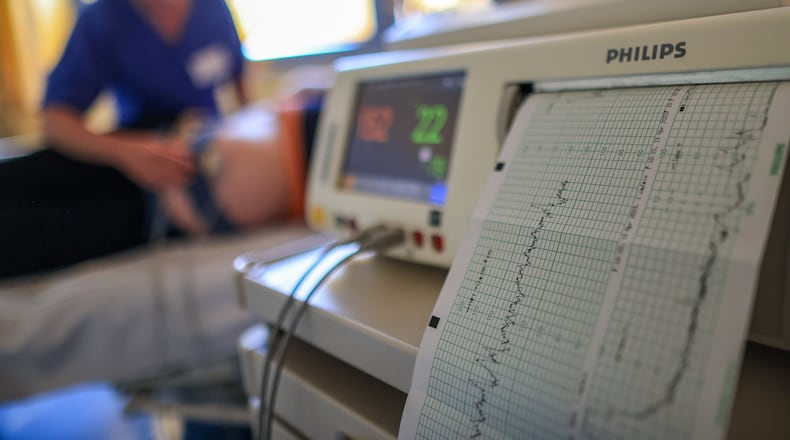Georgia’s ranking among the top five states for cesarean sections rates may only play a small role in the state’s high maternal and infant death pattern. But some Atlanta OB-GYNs remain concerned — and at least two area health systems are trying to reverse the trend.
Georgia joined several states with the fourth highest cesarean delivery or C-section rates in the country (27.5%) for low-risk, first-time mothers, according to a new report by the Leapfrog Group, a nonprofit watchdog organization that advocates for patient safety. The rate, or percentage of live births that were C-sections, is higher than the national average of 25.3%, according to Leapfrog’s 2025 Maternity Care Report.
In recent years, Georgia and national rates have been increasing with the state ranking among the highest in the country.
“Absolutely it’s troubling to see the general rise in rates of C-section nationally and in Georgia as well,” said Adrienne Zertuche, an OB-GYN at Piedmont Women’s Healthcare. “A C-section is considered a major surgery.”
Credit: Patrick Heagney
Credit: Patrick Heagney
Doctors generally perform unplanned C-sections if the labor is not progressing normally or if they are concerned about changes in the baby’s heartbeat, among other complications, according to the American College of Obstetricians and Gynecologists. C-sections require a longer recovery time and come with a slightly higher risk than vaginal deliveries for bleeding, infection and injury to the bowel or bladder, ACOG states.
C-sections also can increase future pregnancy risks and cause pelvic pain from the surgery scarring, Zertuche said.
The top rates in the country were in Mississippi, New York and Massachusetts. Rhode Island, Connecticut and Georgia had the same average C-section rates, the Leapfrog report shows. The rates reflect C-sections of first-time mothers with single, full-term babies in the head-down position based on data from 1,700 hospitals.
“As long as the patient is low risk and her pregnancy is without complications, vaginal delivery has long been confirmed as the safest mode of delivery for the mom,” she said. “Certainly there are benefits to a C-section,” Zertuche admits, citing lower rates of involuntary urine leakage and less pain in the vaginal area.
“I counsel patients about the pros and cons, the risks and benefits. A lot of patients change their minds.”
One of the risk factors for C-section is advanced maternal age, which applies to women over 35, she said. With women continuing to delay pregnancy as their careers progress, they face a higher chance of delivery complications that require C-sections.
Zertuche estimates about half her patients fall in that age category. “I have many who are above 40.”
Credit: Obstetrics & Gynecology of Atlanta
Credit: Obstetrics & Gynecology of Atlanta
The age of birthing mothers has continued to rise over the past five years, said Tom Sharon, an OB-GYN at Obstetrics & Gynecology of Atlanta and Northside’s OBsection chief. The trend of women delaying pregnancy that began decades ago is not showing signs of reversing course any time soon, he added.
Another driver of higher C-section rates nationwide may be the fear some doctors have of waiting too long before deciding to perform a C-section, increasing the patient’s delivery complications and then being slapped with multimillion dollar medical malpractice complaints.
Last month, the Georgia General Assembly passed legislation to limit lawsuits and curb some large jury awards. Gov. Brian Kemp is expected to sign it soon.
As the state’s largest birthing center, Northside is trying to make a dent in the C-section rates, Sharon said. “We’ve been doing a lot of education with doctors at the hospital in the last two years trying to remind them that sometimes they can wait and they don’t have to jump to a C-section.”
Sharon believes Northside has seen some progress. “Lowering the rate 1% is a big deal.” The goal is to reduce the rate of C-sections from 30% to 25% of all first-time mothers.
Credit: Carol Hook
Credit: Carol Hook
Emory Healthcare also encourages its doctors to hold out as long as possible for a vaginal delivery, said Dawn Russell, an OB-GYN with Emory Johns Creek Hospital. But many patients have chronic conditions such as obesity, high blood pressure or diabetes that complicate their care and increase the need for a C-section, she said. “They do not tolerate labor in a way someone without such a diagnosis could.”
In addition to providing general health education, Emory is organizing support groups for prenatal patients at a similar stage of pregnancy to help empower them to be more involved in their own care, Russell said.
“A lot of education still is not getting to everyone.” The support groups offer a more personalized path for promoting healthy pregnancies," Russell said. Emory started similar groups before the COVID-19 pandemic, which prevented them from continuing, so this is a renewed and more organized effort.
Sharon cited a sicker patient population in Georgia and the need for improved maternal care, particularly in rural areas. “If (patients) have to drive hours for care, they basically are not going to get it.”
About 42% of Georgia’s counties are considered maternity care deserts compared to about 35% in the United States, according a report last year by the March of Dimes. Georgia’s rate of preterm births and infant and maternal mortality are higher than the national average, March of Dimes reports.
Women in Georgia’s maternity care deserts travel twice as far to reach their nearest obstetric hospital, an average of 32 minutes, compared to the 15 minutes traveled by those living in counties with full access to such care.
To reduce maternal mortality, doctors who recommend inducing labor at 37 weeks for pregnant women with chronic health conditions may increase the patient’s risk for C-section, Sharon said. If the patient is healthy, waiting until at least 39 weeks of pregnancy will increase the chance of vaginal delivery, he said.
The vast majority of patients still prefer to deliver vaginally, he said. “It’s safer and the recovery is faster. Childbearing is a natural phenomenon. People look forward to proceeding naturally if they are healthy and they can.”
Roni Robbins has been a journalist for 37 years. This is her second stint as a freelance reporter for the AJC. She also freelances for Medscape, where she was an editor. Her writing has appeared in WebMD, HuffPost, Forbes, NY Daily News, BioPharma Dive, MNN, Adweek, Healthline and others. She’s also the author of the multiaward-winning novel “Hands of Gold: One Man’s Quest to Find the Silver Lining in Misfortune.”
About the Author
Keep Reading
The Latest
Featured





